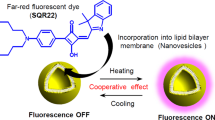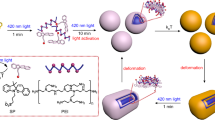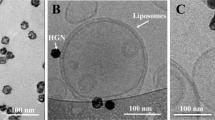Abstract
Molecular self-assembly is the basis for the formation of numerous artificial nanostructures1,2. The self-organization of peptides3,4,5,6, amphiphilic molecules composed of fused benzene rings7,8,9,10 and other functional molecules11,12,13,14,15 into nanotubes is of particular interest. However, the design of dynamic, complex self-organized systems that are responsive to external stimuli remains a significant challenge16. Here, we report self-assembled, vesicle-capped nanotubes that can be selectively disassembled by irradiation. The walls of the nanotubes are 3-nm-thick bilayers and are made from amphiphilic molecules with two hydrophobic legs that interdigitate when the molecules self-assemble into bilayers. In the presence of phospholipids, a phase separation between the phospholipids and the amphiphilic molecules creates nanotubes, which are end-capped by vesicles that can be chemically altered or removed and reattached without affecting the nanotubes. The presence of a photoswitchable and fluorescent core in the amphiphilic molecules allows fast and highly controlled disassembly of the nanotubes on irradiation, and distinct disassembly processes can be observed in real time using fluorescence microscopy.
This is a preview of subscription content, access via your institution
Access options
Subscribe to this journal
Receive 12 print issues and online access
$259.00 per year
only $21.58 per issue
Buy this article
- Purchase on Springer Link
- Instant access to full article PDF
Prices may be subject to local taxes which are calculated during checkout




Similar content being viewed by others
References
Whitesides, G. M. & Grzybowski, B. Self-assembly at all scales. Science 295, 2418–2421 (2002).
Du, J. & O'Reilly, R. K. Advances and challenges in smart and functional polymer vesicles. Soft Matter 5, 3544–3561 (2009).
Ghadiri, M. R., Granja, J. R. & Buehler, L. K. Artificial transmembrane ion channels from self-assembling peptide nanotubes. Nature 369, 301–304 (1994).
Reches, M. & Gazit, E. Casting metal nanowires within discrete self-assembled peptide nanotubes. Science 300, 625–627 (2003).
Adler-Abramovich, L. et al. Self-assembled arrays of peptide nanotubes by vapour deposition. Nature Nanotech. 4, 849–854 (2009).
Lin, Y., Qiao, Y., Tang, P., Li, Z. & Huang, J. Controllable self-assembled laminated nanoribbons from dipeptide-amphiphile bearing azobenzene moiety. Soft Matter 7, 2762–2769 (2011).
Hill, J. P. et al. Self-assembled hexa-peri-hexabenzocoronene graphitic nanotube. Science 304, 1481–1483 (2004).
Borzsonyi, G. et al. Water-soluble J-type rosette nanotubes with giant molar ellipticity. J. Am. Chem. Soc. 132, 15136–15139 (2010).
Yin, M. et al. Functionalization of self-assembled hexa-peri-hexabenzocoronene fibers with peptides for bioprobing. J. Am. Chem. Soc. 131, 14618–14619 (2009).
Zhang, W., Jin, W., Fukushima, T., Ishii, N. & Aida, T. Metal-ion-coated graphitic nanotubes: controlled self-assembly of a pyridyl-appended gemini-shaped hexabenzocoronene amphiphile. Angew. Chem. Int. Ed. 48, 4747–4750 (2009).
Shao, H. et al. Amphiphilic self-assembly of an n-type nanotube. Angew. Chem. Int. Ed. 49, 7688–7691 (2010).
Kim, H. et al. Self-dissociating tubules from helical stacking of noncovalent macrocycles. Angew. Chem. Int. Ed. 49, 8471–8475 (2010).
Eisele, D. M., Knoester, J., Kirstein, S., Rabe, J. P. & Vanden Bout, D. A. Uniform exciton fluorescence from individual molecular nanotubes immobilized on solid substrates. Nature Nanotech. 4, 658–663 (2009).
Palmer, L. C. & Stupp, S. I. Molecular self-assembly into one-dimensional nanostructures. Acc. Chem. Res. 41, 1674–1684 (2008).
Jin, W. et al. Self-assembled graphitic nanotubes with one-handed helical arrays of a chiral amphiphilic molecular graphene. Proc. Natl Acad. Sci. USA 102, 10801–10806 (2005).
Roy, D., Cambre, J. N. & Sumerlin, B. S. Future perspectives and recent advances in stimuli-responsive materials. Prog. Polym. Sci. 35, 278–301 (2010).
Service, R. F. How far can we push chemical self-assembly. Science 309, 95 (2005).
Vollmer, M. S., Clark, T. D., Steinem, C. & Ghadiri, M. R. Photoswitchable hydrogen-bonding in self-organized cylindrical peptide systems. Angew. Chem. Int. Ed. 38, 1598–1601 (1999).
Goodwin, A. P., Mynar, J. L., Ma, Y. Z., Fleming, G. R. & Frechet, J. M. J. Synthetic micelle sensitive to IR light via a two-photon process. J. Am. Chem. Soc. 127, 9952–9953 (2005).
Mynar, J. L. et al. Two-photon degradable supramolecular assemblies of linear-dendritic copolymers. Chem. Commun. 20, 2081–2082 (2007).
Parthasarathy, P. et al. Spatially controlled assembly of nanomaterials at the nanoscale. J. Nanosci. Nanotech. 9, 650–654 (2009).
Wang, Y., Xu, H. & Zhang, X. Tuning the amphiphilicity of building blocks: controlled self-assembly and disassembly for functional supramolecular materials. Adv Mater. 21, 2849–2864 (2009).
Muraoka, T., Koh, C., Cui, H. & Stupp, S. I. Light-triggered bioactivity in three dimensions. Angew. Chem. Int. Ed. 48, 5946–5949 (2009).
Browne, W. R., Pollard, M. M., de lange, B., Meetsma, A. & Feringa, B. L. Reversible three-state switching of luminescence: a new twist to electro and photochromic behavior. J. Am. Chem. Soc. 128, 12412–12413 (2006).
Coleman, A. C. et al. In situ generation of wavelength-shifting donor–acceptor mixed-monolayer-modified surfaces. Angew. Chem. Int. Ed. 49, 6580–6584 (2010).
Pearlman, D. A. et al. Amber, a package of computer programs for applying molecular mechanics, normal-mode analysis, molecular-dynamics and free-energy calculations to simulate the structural and energetic properties of molecules. Comput. Phys. Commun. 91, 1–41 (1995).
Tahara, Y. & Fujiyoshi, Y. A new method to measure bilayer thickness — cryoelectron microscopy of frozen-hydrated liposomes and image simulation. Micron 25, 141–149 (1994).
Stuart, M. C. A. & Boekema, E. J. Two distinct mechanisms of vesicle-to-micelle and micelle-to-vesicle transition are mediated by the packing parameter of phospholipid-detergent systems. Biochim. Biophys. Acta Biomembr. 1768, 2681–2689 (2007).
Brown, D. A. & London, E. Functions of lipid rafts in biological membranes. Annu. Rev. Cell Dev. Biol. 14, 111–136 (1998).
Acknowledgements
The authors thank the Zernike Institute for Advanced Materials (A.C.C. and J.T.M.) for funding and the US National Science Foundation (NSF) for an NSF International Postdoctoral Fellowship OISE-0853019 (J.M.B.). This project was supported by The Netherlands Organization for Scientific Research (NWO-CW) and the European Research Council (grant no. 227897).
Author information
Authors and Affiliations
Contributions
B.L.F. conceived the research. B.L.F., A.C.C., J.M.B., W.R.B. and B.M. designed the experiments. Synthesis of the amphiphile was carried out by B.M., D.J.v.D. and J.C. Solution photochemical studies, switching studies and tube generation were carried out by A.C.C. and B.M. Cryo-TEM was carried out by M.C.A.S. Molecular models were generated by G.C. Confocal microscope and epifluorescence studies were carried out by J.M.B. and J.T.M. A.C.C., J.M.B., W.R.B. and B.L.F. co-wrote the paper. All authors discussed the results and commented on the manuscript.
Corresponding author
Ethics declarations
Competing interests
The authors declare no competing financial interests.
Supplementary information
Supplementary information
Supplementary information (PDF 4284 kb)
Supplementary information
Supplementary movie 1 (WMV 2764 kb)
Supplementary information
Supplementary movie 2 (WMV 1020 kb)
Supplementary information
Supplementary movie 3 (WMV 2817 kb)
Supplementary information
Supplementary movie 4 (WMV 2606 kb)
Supplementary information
Supplementary movie 5 (WMV 7582 kb)
Supplementary information
Supplementary movie 6 (WMV 8176 kb)
Rights and permissions
About this article
Cite this article
Coleman, A., Beierle, J., Stuart, M. et al. Light–induced disassembly of self-assembled vesicle-capped nanotubes observed in real time. Nature Nanotech 6, 547–552 (2011). https://doi.org/10.1038/nnano.2011.120
Received:
Accepted:
Published:
Issue Date:
DOI: https://doi.org/10.1038/nnano.2011.120
This article is cited by
-
Modular assembly of metal nanoparticles/mesoporous carbon two-dimensional nanosheets
NPG Asia Materials (2023)
-
Light-activated photodeformable supramolecular dissipative self-assemblies
Nature Communications (2022)
-
Manipulating the rotation modes by electricity and light based on the second-generation molecular motor
Applied Physics A (2022)
-
Light-directed trapping of metastable intermediates in a self-assembly process
Nature Communications (2020)
-
Programming chain-growth copolymerization of DNA hairpin tiles for in-vitro hierarchical supramolecular organization
Nature Communications (2019)



